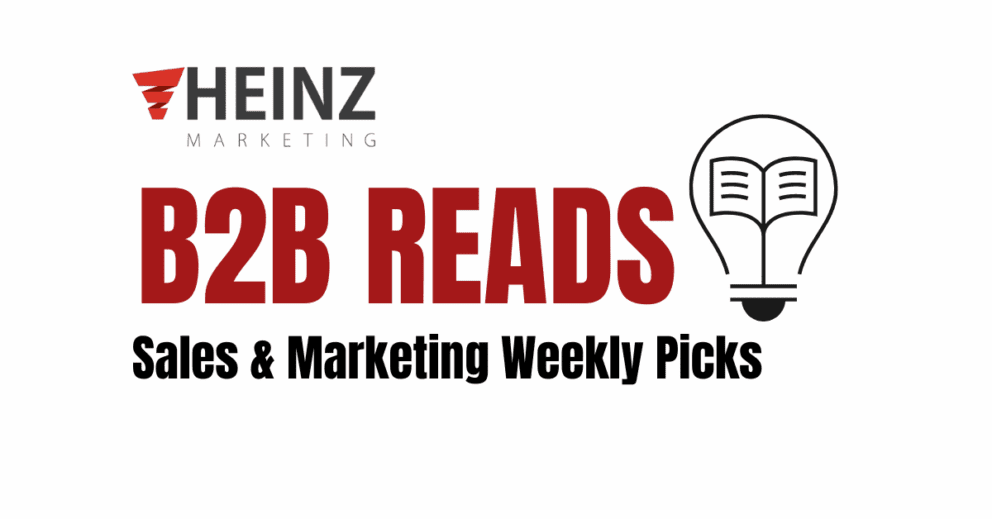Building a More Efficient, Aligned Pipeline: A CMO’s Playbook for CFO Buy-In

Summary
If you’re a marketing leader looking to secure CFO support for your go-to-market strategy, this article gives you a proven framework to increase efficiency, strengthen sales alignment, and demonstrate measurable ROI. You’ll learn how refining your targeting and qualification processes, combined with tighter collaboration with sales, can maximize marketing’s impact on pipeline—and build the financial confidence your CFO needs to greenlight investment.
By Maria Geokezas Chief Operating Officer at Heinz Marketing
In an environment where marketing budgets are under constant scrutiny, CMOs must show that every dollar is working efficiently to drive revenue. Marketing efficiency comes down to two critical levers: targeting the right buyers from the start, and aligning closely with sales to ensure those opportunities convert. Without both, marketing risks wasted spend, frustrated sales teams, and CFO skepticism. The good news? By refining targeting and strengthening alignment, CMOs can cut waste, accelerate pipeline, and earn the financial confidence of their CFO.
Why Marketing Efficiency Matters to CFOs
It’s estimated that only 27% of marketing-generated leads ever get a follow-up from sales and Forrester reports just 1% of all leads convert to closed deals—an alarmingly low return. These stats highlight that marketing teams often chase volume over fit, flooding sales with low-quality leads. The CFO sees this as sunk cost: budget spent on leads that won’t convert.
Sharpening Targeting and Qualification to Eliminate Waste
The good news is that CMOs can drastically reduce this waste – and gain CFO confidence – by refining their targeting and lead qualification processes.
ICPs help “achieve desired results with minimal waste.”
It starts with a crystal-clear Ideal Customer Profile (ICP). An ICP acts as the North Star for whom marketing should (and shouldn’t) attract. By focusing on specific firmographics, intent signals, and pain points that define high-value customers, CMOs ensure their campaigns reach the prospects most likely to become profitable buyers.
When marketing zeroes in on ideal-fit prospects, every dollar of demand gen spend works harder, yielding higher response rates and conversion percentages instead of ballooning the database with irrelevant contacts.
How Lead Qualification Operationalizes Your ICP
Qualification is equally important. Driving tons of leads means little if they’re not vetted. Best-in-class marketing teams implement rigorous lead scoring and qualification criteria agreed upon with sales. This ensures only leads meeting certain readiness or fit thresholds get passed on. Without a structured qualification process, sales reps burn hours on dead-end conversations.
Tightening the Funnel to Deliver Measurable ROI
We call this ‘tightening the front end of the funnel’—using targeted content and campaigns to engage specific companies and buyer personas while filtering out poor-fit prospects early. By narrowing the focus from the start, marketing increases efficiency and ensures every dollar invested is working toward a measurable return the CFO can count on. Tactics include:
- Account-Based Marketing (ABM): focusing on a list of high-value target accounts rather than broad audiences, ensuring resources go toward prospects that match revenue sweet spots.
- Intent data and signals: leveraging third-party intent insights or website engagement to identify leads showing buying signals, then fast-tracking those for sales outreach.
- Lead scoring models: assigning point values to lead activities (web visits, content downloads, email engagement) and demographics, so only those scoring above a threshold (indicating genuine interest and fit) are sent to sales.
- Quick follow-up SLAs: establishing service-level agreements that sales contacts MQLs within e.g. 24 hours. Given that 78% of buyers choose the vendor that responds first, rapid engagement can make the difference between a conversion and a wasted lead.
Aligning Marketing and Sales – The Efficiency Multiplier
Even the best targeting strategy can falter if marketing and sales aren’t working from the same playbook. Lack of alignment between these teams is a silent budget-killer: leads slip through cracks, messaging to prospects diverges, and resources are duplicated or misallocated. For CMOs seeking CFO approval, showcasing a tight sales-marketing alignment is key to proving that GTM investments will be efficient and effective.
Why does alignment matter financially? Research shows that organizations with strong sales and marketing cohesion dramatically outperform those without. A famous Aberdeen Group study found that highly aligned organizations achieve 32% annual revenue growth, whereas poorly aligned ones see a 7% revenue decline. Plus, Forrester notes that aligned departments grow 19% faster and are 15% more profitable than their peers. The reasons are clear: alignment means marketing’s leads are exactly what sales needs, and sales diligently pursues the opportunities marketing generates. There’s no finger-pointing, only shared success metrics.
How alignment IMPRoves marketing efficiency
- Lead Definition: When marketing and sales agree on what a qualified lead is, marketing can tailor campaigns to produce those leads, and sales will follow up consistently. No more marketing saying “we sent sales 500 leads” while sales says “none of those were any good.” Instead, both work a singular funnel.
- Collaborative Planning: Aligned teams plan campaigns and sales outreach together, preventing redundant spend. For example, if marketing is targeting a certain industry in Q3, sales can prioritize outreach and follow-up activities on that segment.
- Consistent Messaging: Prospects hear one coherent story. According to LinkedIn research, 90% of sales and marketing professionals see disconnects in strategy and content between their teams, which can confuse customers and waste marketing content efforts.
- Data Sharing: Marketing and sales share systems and feedback loops. This closed-loop reporting helps cut out campaigns that don’t produce pipeline, reallocating budget to those that do.
By tightening targeting and aligning with sales, CMOs can improve marketing efficiency, cutting waste, boosting pipeline, and delivering the financial predictability CFOs demand. Marketing becomes a precision engine—earning the CFO’s trust and a better position to negotiate for the budgets they need.
Need some help demonstrating the efficiency of your marketing programs? Come talk with us about your ICP. See if you qualify for a free ICP analysis.





